A brief and shallow correction was expected to continue lower to 3,130. Downwards movement continued further than expected, reaching a low at 3,110.78.
Summary: Minor wave 4 may have begun. It may continue for about two weeks or so and may find support about 3,081. It may be a choppy overlapping consolidation. Thereafter, the upwards trend may resume. The next target is at 3,302 and then 3,336.
Three large pullbacks or consolidations during the next 1-2 years are expected: for minor wave 4, then intermediate (4), and then primary 4. Prior to each of these large corrections beginning, some weakness may begin to be evident.
The biggest picture, Grand Super Cycle analysis, is here.
Monthly charts were last published here, with video here. There are two further alternate monthly charts here, with video here.
ELLIOTT WAVE COUNTS
The two weekly Elliott wave counts below will be labelled First and Second. They may be about of even probability. When the fifth wave currently unfolding on weekly charts may be complete, then these two wave counts will diverge on the severity of the expected following bear market. To see an illustration of this future divergence monthly charts should be viewed.
FIRST WAVE COUNT
WEEKLY CHART
The basic Elliott wave structure consists of a five wave structure up followed by a three wave structure down (for a bull market). This wave count sees the bull market beginning in March 2009 as an incomplete five wave impulse and now within the last fifth wave, which is labelled cycle wave V. This impulse is best viewed on monthly charts. The weekly chart focusses on the end of it.
Elliott wave is fractal. This fifth wave labelled cycle wave V may end a larger fifth wave labelled Super Cycle wave (V), which may end a larger first wave labelled Grand Super Cycle wave I.
The teal Elliott channel is drawn using Elliott’s first technique about the impulse of Super Cycle wave (V). Draw the first trend line from the end of cycle wave I (off to the left of the chart, the weekly candlestick beginning 30th November 2014) to the end of cycle wave III, then place a parallel copy on the end of cycle wave II. This channel perfectly shows where cycle wave IV ended at support. The strongest portion of cycle wave III, the end of primary wave 3, overshoots the upper edge of the channel. This is a typical look for a third wave and suggests the channel is drawn correctly and the way the impulse is counted is correct.
Within Super Cycle wave (V), cycle wave III is shorter than cycle wave I. A core Elliott wave rule states that a third wave may never be the shortest. For this rule to be met in this instance, cycle wave V may not be longer in length than cycle wave III. This limit is at 3,477.39.
Cycle wave V may subdivide either as an impulse or an ending diagonal. Impulses are much more common. An alternative wave count which considered an ending diagonal has been invalidated. While it is possible a diagonal may become an alternate wave count in coming weeks or months, at this stage the structure does not fit.
At this stage, cycle wave V may take another one to two or so years to complete.
The daily chart below will focus on movement from the end of intermediate wave (1) within primary wave 3.
In historic analysis, two further monthly charts have been published that do not have a limit to upwards movement and are more bullish than this wave count. Members are encouraged to consider those possibilities (links below summary) alongside the wave counts presented on a daily and weekly basis.
Within cycle wave V, primary waves 1 and 2 may be complete. Within primary wave 3, intermediate waves (1) and (2) may be complete. Within the middle of intermediate wave (3), no second wave correction may move beyond its start below 2,855.96.
DAILY CHART
All of primary wave 3, intermediate wave (3) and minor wave 3 may only subdivide as impulses.
Minor wave 3 may be complete. Minor wave 3 now shows an increase in momentum beyond minor wave 1; MACD supports this wave count.
Minor wave 2 was a sharp deep pullback, so minor wave 4 may be expected to be a very shallow sideways consolidation to exhibit alternation. Minor wave 2 lasted 2 weeks, so minor wave 4 may be about the same duration to have good proportion.
Minor wave 4 may not move into minor wave 1 price territory below 3,021.99.
Intermediate wave (3) must move far enough above the end of intermediate wave (1) to then allow intermediate wave (4) to unfold and remain above intermediate wave (1) price territory. While intermediate wave (3) has now moved beyond the end of intermediate wave (1), meeting a core Elliott wave rule, it still needs to continue higher to give room for intermediate wave (4).
The target for intermediate wave (3) fits with a target calculated for minor wave 3.
Draw an Elliott channel now about intermediate wave (3) using Elliott’s first technique: draw the first trend line from the ends of minor waves 1 to 3, then place a parallel copy on the end of minor wave 2. If it is time consuming enough, then minor wave 4 may find support about the lower edge of this blue channel (although it looks like it may end midway within the channel).
HOURLY CHART
Minor wave 3 is now relabelled as complete.
Within the impulse of minor wave 3, the triangle for minuette wave (iv) is relabelled as a more time consuming running contracting triangle. Minor wave 3 exhibits no Fibonacci ratio to minor wave 1.
Fibonacci ratios within minor wave 3 are: there is no Fibonacci ratio between minute waves iii and i, and minute wave v is just 1.29 points short of 0.618 the length of minute wave i.
Minor wave 2 was a deep sharp zigzag lasting ten sessions. Given the guideline of alternation, minor wave 4 would least likely subdivide as a zigzag and may more likely subdivide as one of either a triangle, combination or flat correction. Triangles and combinations particularly are usually longer lasting structures than zigzags, so minor wave 4 may last longer than ten sessions.
Minor wave 4 would most likely be shallow. The preferred target for support would be either the 0.146 or 0.236 Fibonacci ratios of minor wave 3. The 0.146 Fibonacci ratio is within the price territory of the fourth wave of one lesser degree; minute wave iv has its range from 3,127.64 to 3,091.41.
All of a triangle, combination and flat correction begin with a three wave structure for minute wave a or w. This is almost always a zigzag. Within the first three wave structure, minuette wave (b) may not move beyond the start of minuette wave (a) above 3,154.26.
The labelling within minor wave 4 will probably change as it unfolds over the next two weeks or so; alternate wave counts may be required. Focus should not be on identifying exactly which structure it may be and so predicting each small swing within it. Focus should be on identifying when it may be complete. The breakout when minor wave 4 is complete should be upwards; fourth waves are always continuation patterns within the Elliott wave structure one degree higher.
SECOND WAVE COUNT
WEEKLY CHART
This weekly chart is almost identical to the first weekly chart, with the sole exception being the degree of labelling.
This weekly chart moves the degree of labelling for the impulse beginning in March 2009 all down one degree. This difference is best viewed on monthly charts.
The impulse is still viewed as nearing an end; a fifth wave is still seen as needing to complete higher. This wave count labels it primary wave 5.
Primary wave 5 may be subdividing as either an impulse, in the same way that cycle wave V is seen for the first weekly chart.
TECHNICAL ANALYSIS
MONTHLY CHART
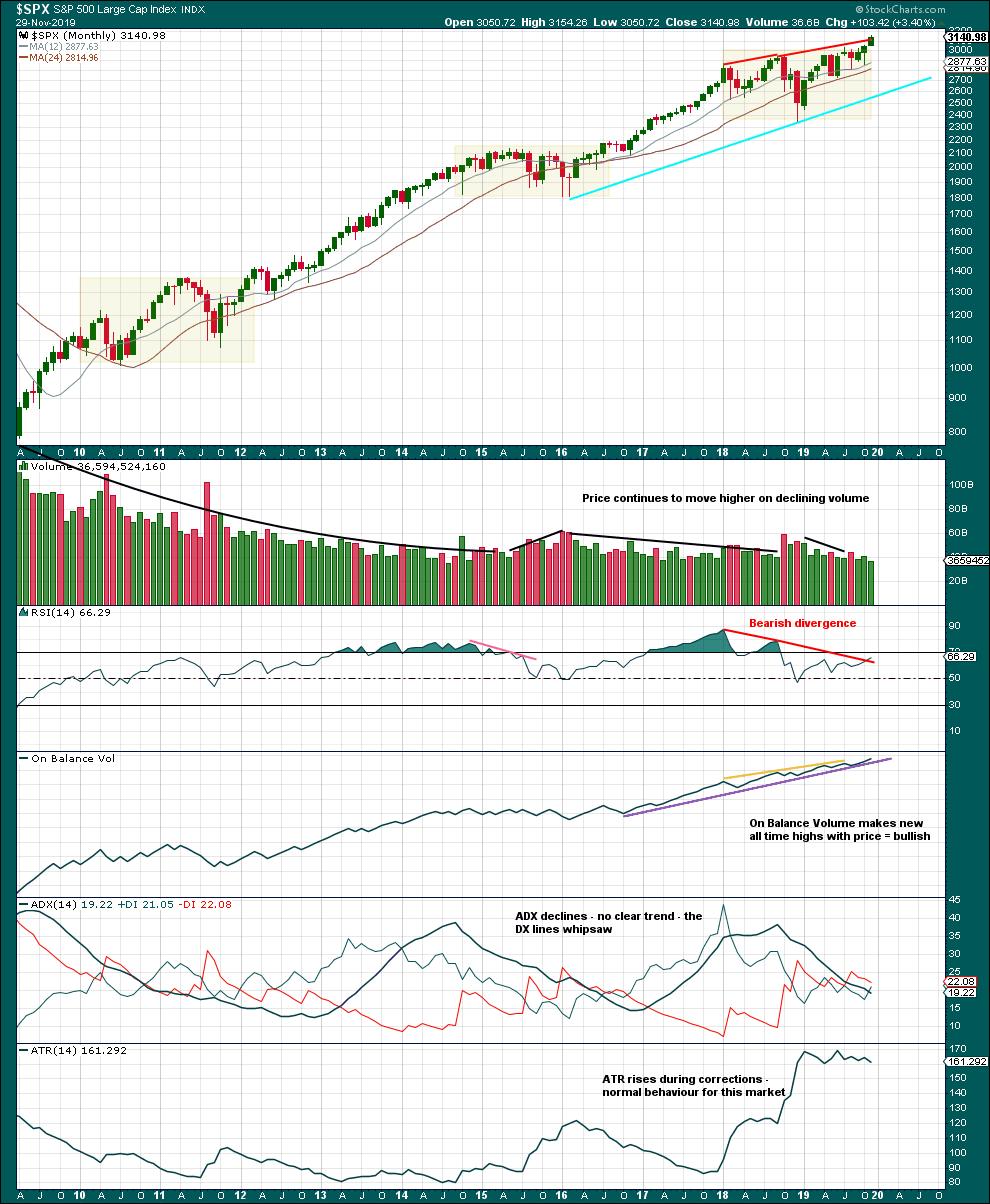
Click chart to enlarge. Chart courtesy of StockCharts.com.
There are three large consolidations noted on this chart, in shaded areas. After a breakout from a multi-month consolidation, it is reasonable to expect a multi month bullish move may result.
This chart very clearly exhibits rising price on declining volume has now persisted for several years. A decline in volume this month, in current market conditions, is not of concern.
On Balance Volume supports the Elliott wave count.
WEEKLY CHART
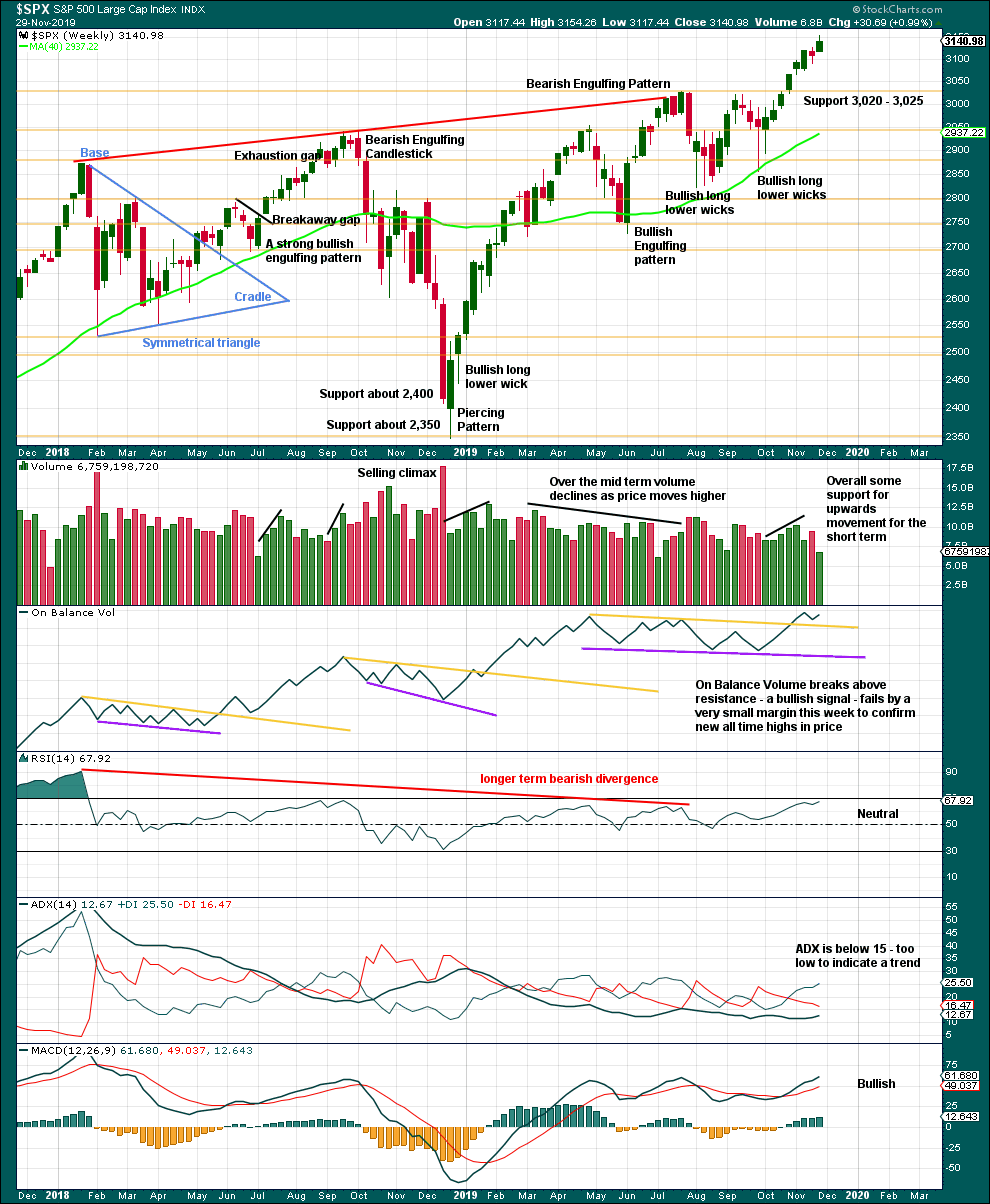
Click chart to enlarge. Chart courtesy of StockCharts.com.
It is very clear that the S&P is in an upwards trend and the bull market is continuing. Price does not move in straight lines; there will be pullbacks and consolidations along the way.
Last week is a short week with New York closed for a day and a half for Thanksgiving Day.
A decline in volume for the last week is acceptable. The failure by On Balance Volume to confirm a new all time high is extremely small, and as this was a short week this shall be given no weight.
Overall, this chart supports the Elliott wave count.
DAILY CHART
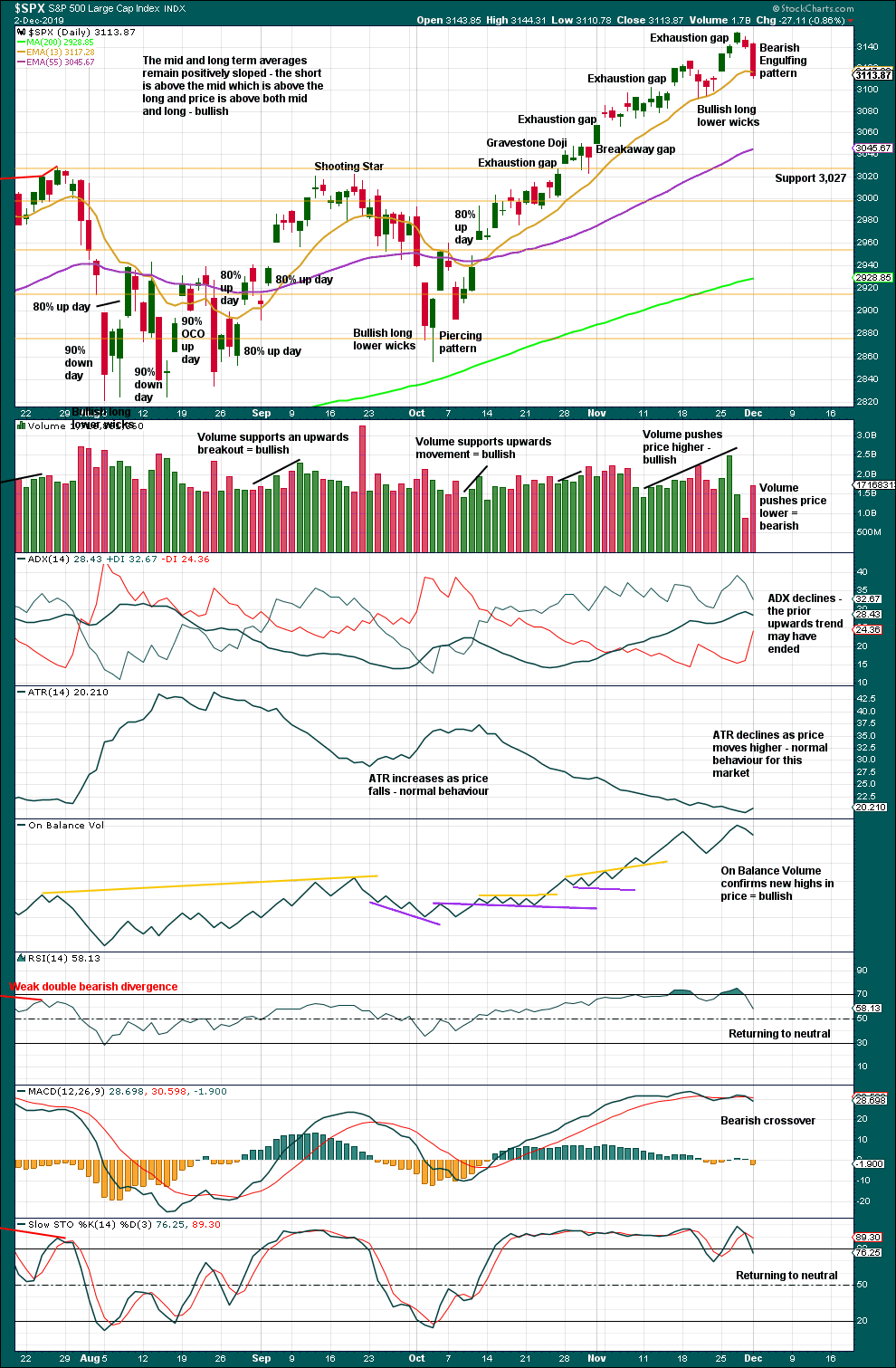
Click chart to enlarge. Chart courtesy of StockCharts.com.
There is an upwards trend in place. There will be corrections along the way.
When this market is in a bullish trend, RSI can reach deeply overbought and remain there for some weeks.
Today a strong downwards session completes a bearish reversal pattern that has support from volume. This should be given weight given that it comes after RSI reached overbought. A larger pullback or consolidation may now be expected. This supports the Elliott wave count which expects minor wave 4 has arrived.
BREADTH – AD LINE
WEEKLY CHART
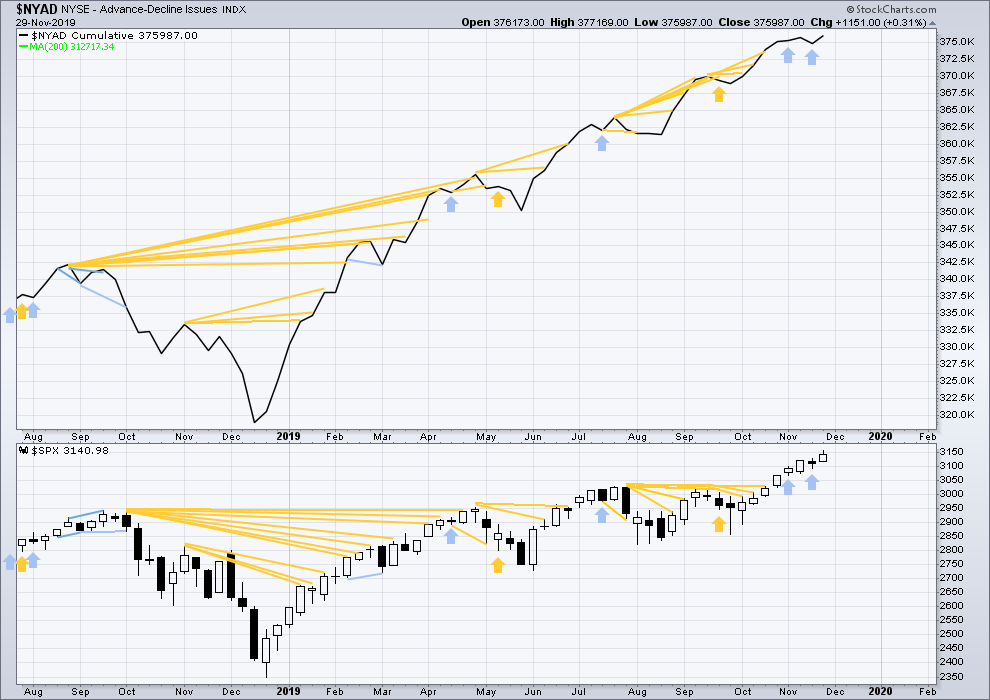
Click chart to enlarge. Chart courtesy of StockCharts.com. So that colour blind members are included, bearish signals
will be noted with blue and bullish signals with yellow.
Bear markets from the Great Depression and onwards have been preceded by an average minimum of 4 months divergence between price and the AD line with only two exceptions in 1946 and 1976. With the AD line making new all time highs last week, the end of this bull market and the start of a new bear market is very likely a minimum of 4 months away, which is mid March 2020.
In all bear markets in the last 90 years there is some positive correlation (0.6022) between the length of bearish divergence and the depth of the following bear market. No to little divergence is correlated with more shallow bear markets. Longer divergence is correlated with deeper bear markets.
If a bear market does develop here, it comes after no bearish divergence. It would therefore more likely be shallow.
All of small, mid and large caps have made new swing highs above the prior swing high on the 13th of September, but only large caps have made new all time highs. This upwards movement appears to be mostly driven by large caps, which is a feature of aged bull markets. This bull market at over 10 years duration certainly fits the definition of aged.
Mid and small caps have not yet made new all time highs.
Last week both price and the AD line have moved higher. Upwards movement this week from price has support from rising market breadth. This is bullish and supports the Elliott wave count.
DAILY CHART
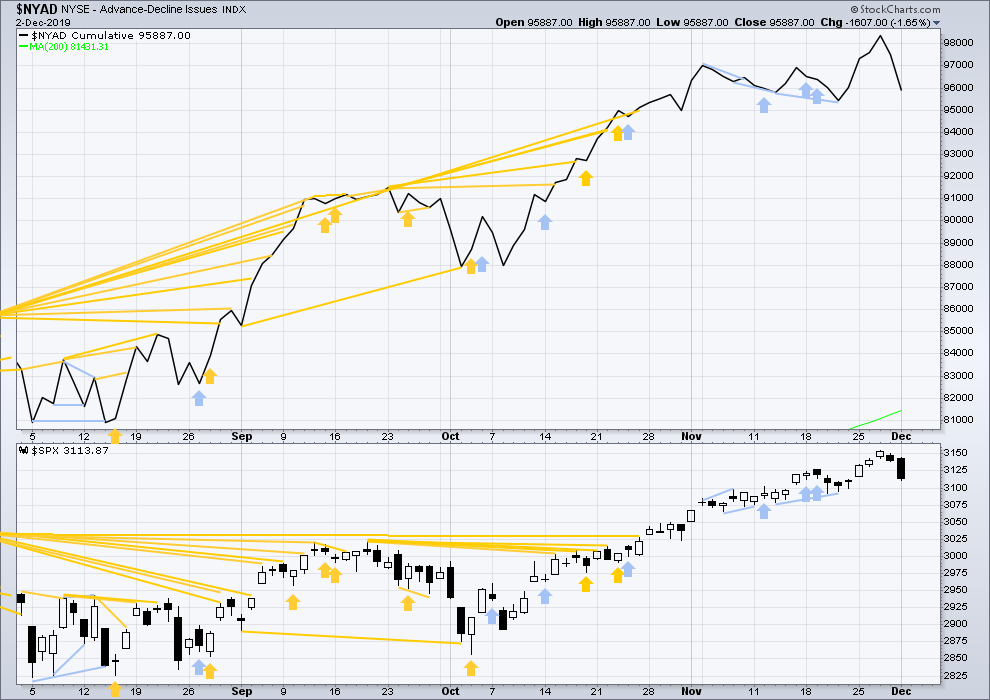
Click chart to enlarge. Chart courtesy of StockCharts.com. So that colour blind members are included, bearish signals
will be noted with blue and bullish signals with yellow.
Breadth should be read as a leading indicator.
Both price and the AD line moved lower again on Monday. Neither have made new short-term swing lows. There is no new divergence.
VOLATILITY – INVERTED VIX CHART
WEEKLY CHART
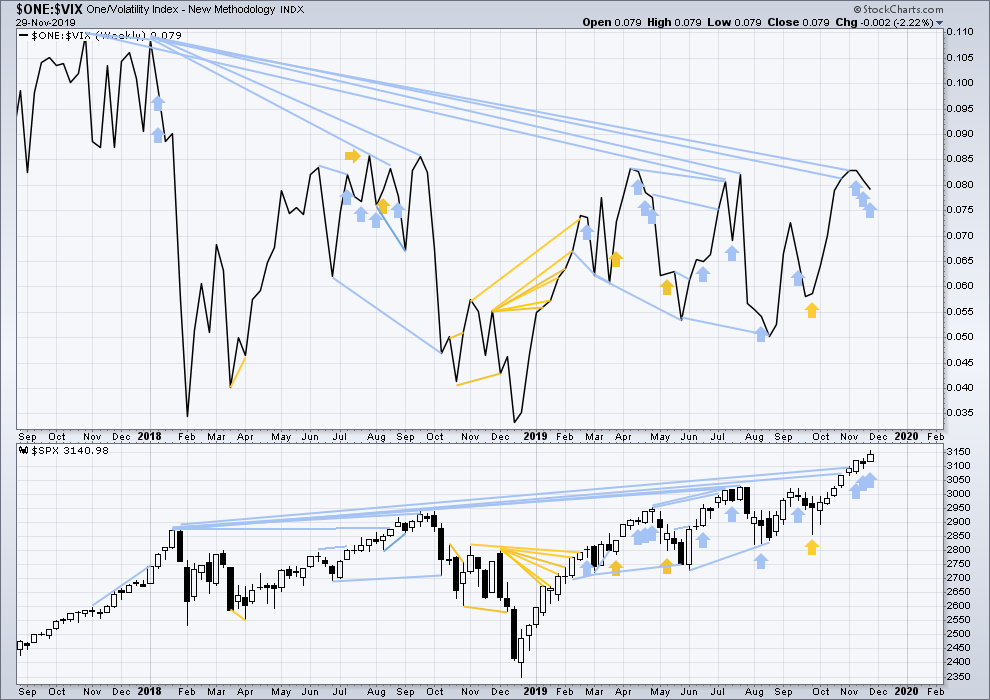
Click chart to enlarge. Chart courtesy of StockCharts.com. So that colour blind members are included, bearish signals
will be noted with blue and bullish signals with yellow.
The all time high for inverted VIX was on 30th October 2017. There is now over two years of bearish divergence between price and inverted VIX.
The rise in price is not coming with a normal corresponding decline in VIX; VIX remains elevated. This long-term divergence is bearish and may yet develop further as the bull market matures.
This divergence may be an early warning, a part of the process of a top developing that may take years. It may is clearly not useful in timing a trend change from bull to a fully fledged bear market.
Price has moved higher for three weeks in a row, but inverted VIX has moved lower. This divergence is now persistent enough to be considered to be sounding a strong warning that there is now reasonable risk to the downside.
The last time this happened was after early January 2018. It was followed by primary wave 4.
DAILY CHART
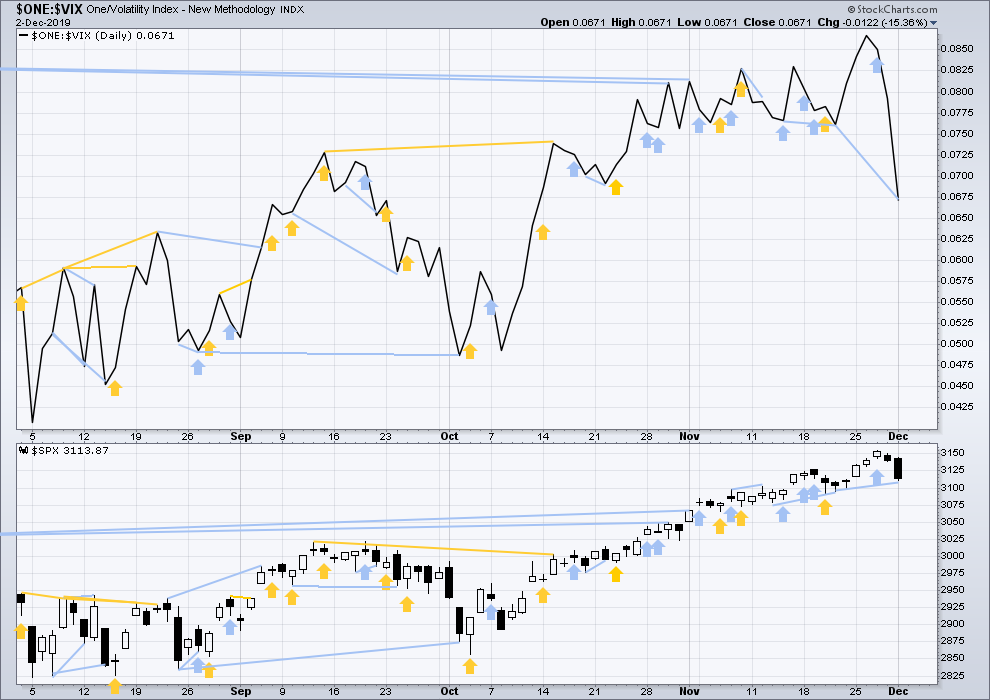
Click chart to enlarge. Chart courtesy of StockCharts.com. So that colour blind members are included, bearish signals
will be noted with blue and bullish signals with yellow.
Both price and inverted VIX have moved lower on Monday. Inverted VIX has made a new swing low, but price has not. This divergence is bearish and strong. This supports the Elliott wave count which expects minor wave 4 has now arrived.
DOW THEORY
Dow Theory confirmed a bear market in December 2018. This does not necessarily mean a bear market at Grand Super Cycle degree though; Dow Theory makes no comment on Elliott wave counts. On the 25th of August 2015 Dow Theory also confirmed a bear market. The Elliott wave count sees that as part of cycle wave II. After Dow Theory confirmation of a bear market in August 2015, price went on to make new all time highs and the bull market continued.
DJIA: 23,344.52 – a close on the 19th of December at 23,284.97 confirms a bear market.
DJT: 9,806.79 – price has closed below this point on the 13th of December.
S&P500: 2,532.69 – a close on the 19th of December at 2,506.96 provides support to a bear market conclusion.
Nasdaq: 6,630.67 – a close on the 19th of December at 6,618.86 provides support to a bear market conclusion.
With all the indices having moved higher following a Dow Theory bear market confirmation, Dow Theory would confirm a bull market if the following highs are made:
DJIA: 26,951.81 – a close above this point has been made on the 3rd of July 2019.
DJT: 11,623.58 – to date DJT has failed to confirm an ongoing bull market.
S&P500: 2,940.91 – a close above this point was made on the 29th of April 2019.
Nasdaq: 8,133.30 – a close above this point was made on the 26th of April 2019.
Published @ 07:24 p.m. EST.
—
Careful risk management protects your trading account(s).
Follow my two Golden Rules:
1. Always trade with stops.
2. Risk only 1-5% of equity on any one trade.
—
New updates to this analysis are in bold.

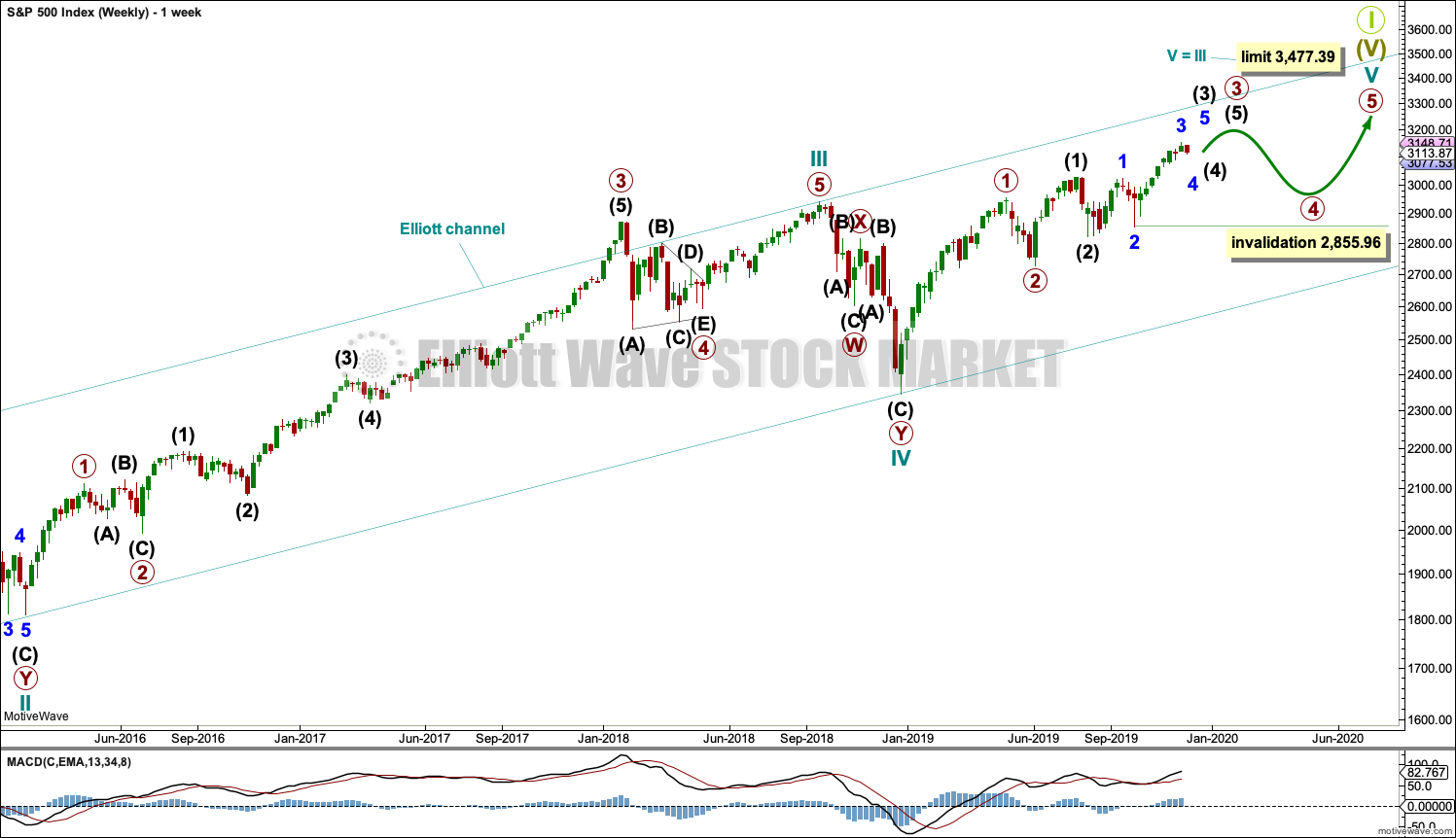
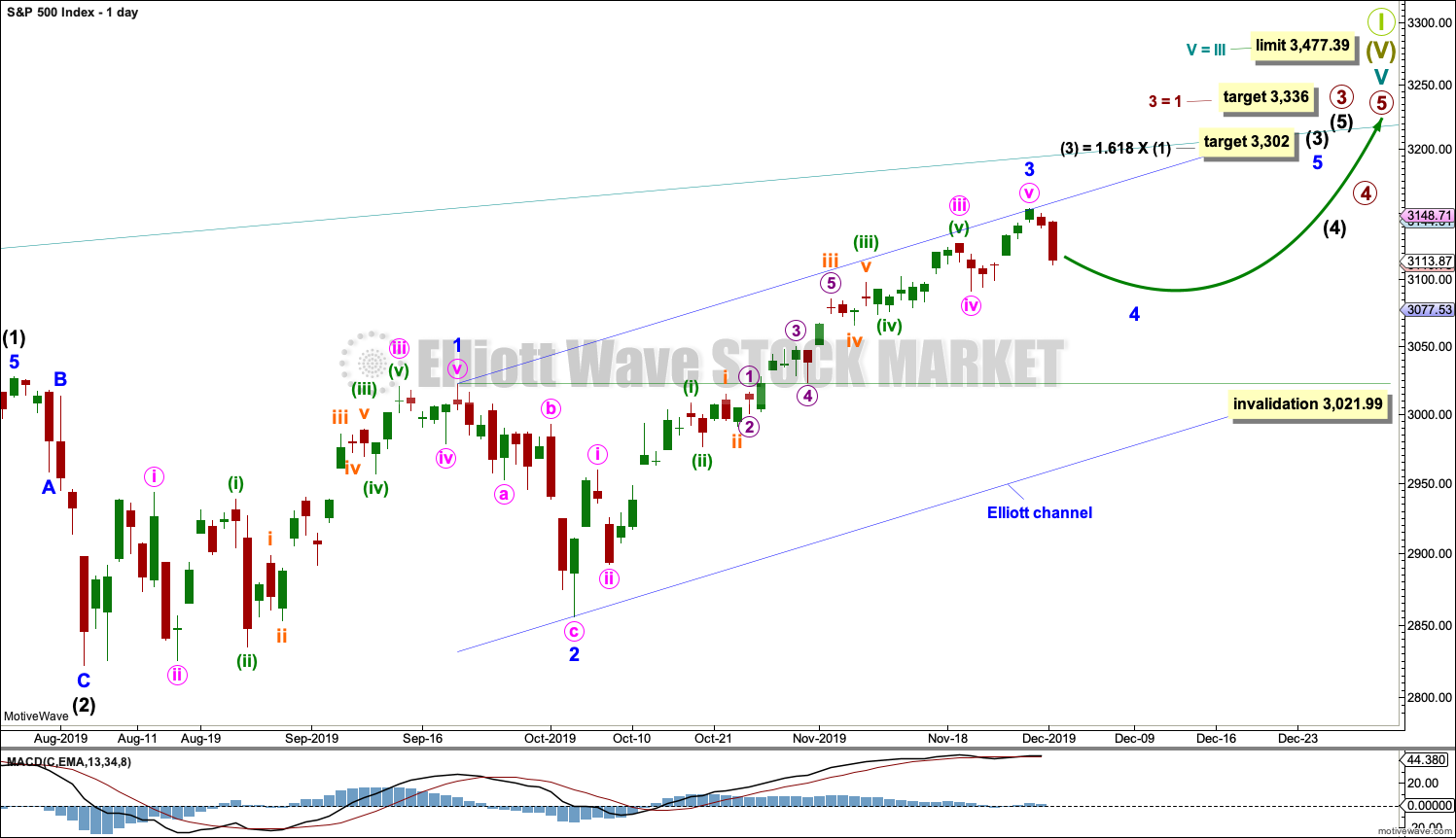

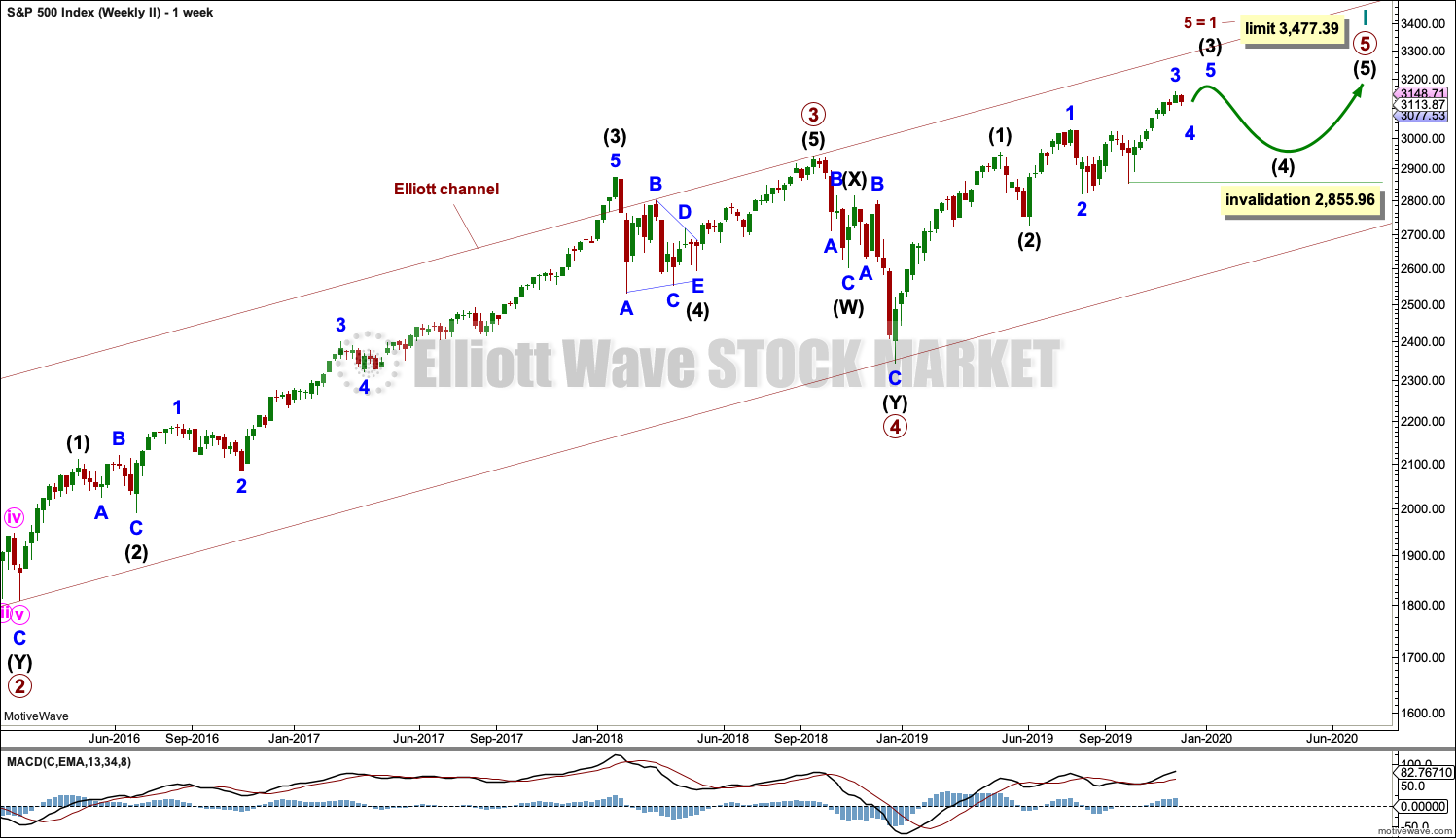
Hourly chart updated.
A five down looks complete. I am still going to label this minuette (a) within a zigzag for minute a.
This chart leans to a more bearish side for the low of minor 4, but it may not get as low as the 0.382 Fibonacci ratio. It may move mostly sideways from here.
Minuette (b) may not move beyond the start of minuette (a) above 3,154.26.
But if minute a completes as a zigzag, then minute b may move beyond the start of minute a above 3,154.26 if minor 4 unfolds as a running triangle or expanded flat or combination.
The invalidation point at 3,154.26 is short term.
Kevin,
I didn’t expect RUT to come this far down.
I hope the minute ii is complete at today’s low.
What do you think?
I bought some
Well that’s some move down in last 2 days, and it seems to be in 3 wave, so IF today marks the completion of A wave of the triangle then we could spend next 2 weeks between the lows & the ATHs
Would prefer it, as it could be some good short term profit opportunities…
The McClellan Oscillator is now around -48 and below its lower Bollinger Band. VIX is above its upper Bollinger Band as it was at the close of yesterday’s trading. This is the place where a rally can materialize bringing on Minute B of Minor 4 which should rally above 3100 SPX before Minute C of Minor 4 takes us much lower.
Ah yes…minor 3 induced by “bad” China trade deal news. Shock and awe.
A couple of months ago, I gave an argument as to why a trade deal with China would not be completed before the November 2020 USA Presidential elections. I stated the Chinese are hopeful that the incumbent would not be re-elected because they would rather negotiate with someone else. Now, our President has stated he may not want to complete the deal before the elections. I believe this is a negotiating tactic to convince the Chinese President that the US will not make a deal unless they give further concessions to the agreement. If and when an agreement materializes, it will be the impetus to new ATH’s and a move above 3300 SPX.
Hi Rodney,
that sounds like the only way for 3300 to show up if the deal is done. So what happens if the deal is not done. How can we achieve 3300 levels in this case? Do es it mean we have more than 2 years to wait for it and recession won’t happen for another 5 years?:)
Lev
Well, I guess the current EW count is indicating that, in fact, a deal (at least Phase 1) would be signed before the election and sooner rather than later. The economy of China is in terrible condition. Even though the Chinese may indicate they do not want to sign a deal, they really need to in order to revive their economy. As the November 2020 elections draw nearer the indications are that the incumbent will win another 4 years. Once the Chinese realize this, they will have no reason to wait any longer.
All of this is mere speculation on my part. I am reminded that the news does not make the market but rather the market makes the news.
While I’m still not sure why but I have to agree with your last statement that market makes the news. I have noticed that so many times before – when market needs to go one way or another, appropriate news show up right at that time. Sometimes it feels like someone is manipulating this whole thing as news show up right at the time when they have to:)
About a week ago, you indicated that Bitcoin had bottomed or would bottom within a week. Are you still of that opinion? Or any additional insights to consider? Thanks
I’m updating BTCUSD this morning, should be published soon.
Anyone short AAPL besides me?
I’m telling ya, Fibonacci projections (the blue line I projected a few weeks back) are powerful ju-ju. Along with exponential runs that zing outside of channel boundaries and then double top exactly at the projected potential pivot level.
Now I need to keep telling myself “hold that short, it’s a hedge!!!”. Because AAPL at 256 now could easy drop to 240 or or 230 or 220…
ps: I have a complete article on Fibonacci fitting (Fibonacci projections) that I’ve submitted to TASC and now Futures Magazine as well. TASC responded positively a few months ago but has gone totally silent on me. If anyone would like to get a private copy of this article (I’m not publishing it on my web site in the hope I can still get it in one of these rags) I’d be happy to send a copy, just hit me up at zinc1024 at the gmail place. I am 100% confident it is a highly functional and wholly new approach to doing swing completion projections, based upon the fundamental Fibonacci structure of swings in progress (vs. the traditional methodology of only considering the Fibo structure of prior swings vs. the state of the current swing).
US bonds broke down hard today. Consistent with that, not quite as impacted today in Spiders was XLF (financials), at only -0.63%. And XLP was even slightly up, while industrials (they’ve been very hot) got a haircut at -1.65%.
Honestly, it looks like a health profit taking 4 wave consolidation so far, exactly as we have modeled. And if bonds keeps dropping, financial will help launch the new 5. Note that XLF is in its 12th candle in a row in a squeeze state, trend is up and momentum is rising. All very bullish.
Note: last week per J. Carter the “easiest trade around” was to go long bonds (this was in a public video so I can repeat it). Oops. Well, we all make mistakes. I didn’t go long bonds…I put on a fly, and so far, price is still in my profit range.
Sorry to diss J. Carter, turns out he called for an exit to the long bond trade on Friday, well done!
Minor 2 was 10 daily candles long. This minor 4 is has now completed 3 daily candles. Finishing 7 more puts us at the middle of next week. That leaves 7 trading days until options expiration, Dec 20, for renewed bullish action. If minor 4 extends to 1.62 of minor 2, that’s about 16 days total, which is just past Dec 20. Here’s to a quick and shallow minor 4.
Thanks for that Kevin, most helpful.
I’d lean towards minor 4 being more time consuming than minor 2 so far…
We shall see!
Easy #1,, hmmm.